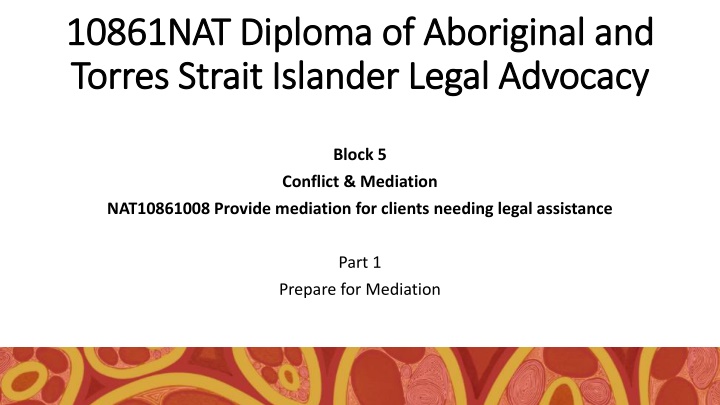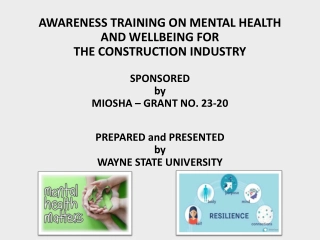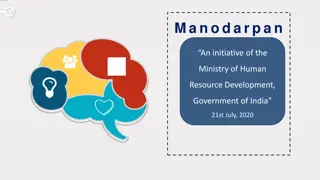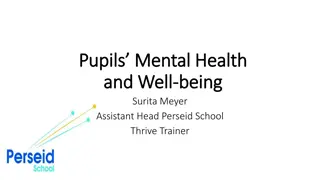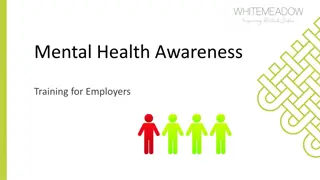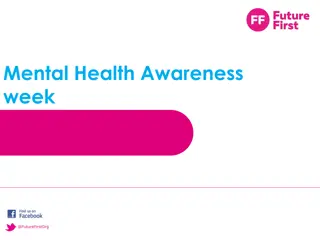The Mental Health & Addictions Quality Initiative
A presentation on The Mental Health and Addictions Quality Initiative, a collaborative project among mental health hospitals in Ontario to define quality indicators, share results, and improve processes. The initiative aims to measure performance in key domains of mental health care, compare facilities, demonstrate accountability, share best practices, and highlight the work of specialty mental health facilities. It includes objectives, indicator selection criteria, the role of the Resident Assessment Instrument for Mental Health, and specific indicators for the project.
Download Presentation

Please find below an Image/Link to download the presentation.
The content on the website is provided AS IS for your information and personal use only. It may not be sold, licensed, or shared on other websites without obtaining consent from the author.If you encounter any issues during the download, it is possible that the publisher has removed the file from their server.
You are allowed to download the files provided on this website for personal or commercial use, subject to the condition that they are used lawfully. All files are the property of their respective owners.
The content on the website is provided AS IS for your information and personal use only. It may not be sold, licensed, or shared on other websites without obtaining consent from the author.
E N D
Presentation Transcript
10861NAT Diploma of Aboriginal and 10861NAT Diploma of Aboriginal and Torres Strait Islander Legal Advocacy Torres Strait Islander Legal Advocacy Block 5 Conflict & Mediation NAT10861008 Provide mediation for clients needing legal assistance Part 1 Prepare for Mediation
Acknowledgement of Country Acknowledgement of Country We acknowledge the traditional owners of the land on which Tranby stands, the Gadigal people of the Eora nation. We pay our respects to their Elders both past and present, who remain the traditional knowledge holders of this land. We proudly extend this respect to all current and emerging leaders around Australia, for they hold the memories, the traditions, the culture and the future of their people.
Mediation Mediation What is Mediation? Mediation is one form of alternative dispute resolution (ADR). ADR refers to various dispute resolution processes and techniques to assist parties to a dispute to come to an agreement with the help of a third party thus avoiding the need to make a complaint to a court. In more recent times, however, ADR has been adopted by courts as a tool to help settle disputes alongside the court system itself. ADR has been adopted as a useful tool by most Australian court systems. Outside the court context, ADR has also become a familiar feature for dealing with disputes in business and community situations.
Mediation Mediation Mediation is a process that promotes the self-determination of participants and in which participants, with the support of a mediator: (a) communicate with each other, exchange information and seek understanding (b) identify, clarify and explore interests, issues and underlying needs (c) consider their alternatives (d) generate and evaluate options (e) negotiate with each other; and (f) reach and make their own decisions.
Mediation Mediation Role of the Mediator The mediator facilitates a process. The mediator cannot make a decision about the outcome of the dispute, or who is right or wrong. A mediator can help people to: Identify the issues in dispute Consider options for dealing with the issues Reach their own negotiated solution
Mediation Mediation A mediator should: Guide participants through discussions about their concerns and issues to help them to explore whether there are solutions that may be acceptable to all involved Be impartial and not take sides Ensure that all relevant concerns and issues in dispute are addressed Assist to break down the relevant concerns and issues in dispute into manageable parts Create an environment where all participants have an equal opportunity to be heard Ensure that discussions do not get out of control Assist participants to examine options for resolving the dispute Assist participants to write down the details of any concluded negotiated agreement.
Mediation Mediation A mediator should not: Provide legal advice Take sides Decide who is right or wrong Make a decision on behalf of participants Make suggestions about what should happen after the conclusion of the mediation Force participants to reach an agreement.
Mediation Mediation In some cases, mediation is not possible because, for example: A mediation is a voluntary process (unless ordered by a court) and one or more potential participants to a dispute may not agree to participation There might be safety concerns or reason to fear violence A person involved in the dispute is unable to speak up for themselves or negotiate on their own behalf and this makes mediation unsuitable The issue affects the wider community, so that there might be a 'public interest' in having a court decide it, or The issues in the dispute are very complex or otherwise not suitable for mediation.
Mediation Mediation Mediation can help resolve disputes involving: neighbours communities or associations money matters families schools workplaces, and businesses.
Mediation Mediation Mediation with Aboriginal and Torres Strait Islanders Some Aboriginal and Torres Strait Islander people may be concerned about the prospect of mediation, considering it to be a European form of dispute resolution and thus culturally alienating and unhelpful. The reasons for this can be various e.g.: The perceived pseudo-judicialising of the mediation process Language barriers Communication barriers (e.g. challenges in accessing reliable and private telephone and internet services) Financial challenges Transport constraints etc.
Mediation Mediation The mediator of a dispute involving Aboriginal and Torres Strait Islander people needs to ensure that the parties are involved in the development of a suitable mediation model with which they are comfortable. Therefore there are certain things to be aware of: 1. Culture It is important to properly prepare the parties so that culture can be incorporated effectively into the mediation experience. For example, it may be important for the mediator to ensure that, before commencing the mediation, there is an appropriate recognition of kinship and acknowledgement of traditional Indigenous ancestors
Mediation Mediation 2. Neutrality and impartiality Given the detailed and complex structures of Aboriginal and Torres Strait Islander family networks, kinship obligations, and far-reaching community knowledge, it may be difficult to find an Aboriginal and Torres Strait Islander mediator who is completely neutral The issue should be decided on a case by case basis and flexibility is necessary in this regard Respected figures within Aboriginal and Torres Strait Islander communities are often valued for their ability to remain impartial. Nevertheless, care needs to be taken to remind the participants that the mediator s role is to assist the parties and not to solve their dispute
Mediation Mediation 3. Confidentiality The requirement of confidentiality is often central to a successful mediation process. The reason for this is to encourage the parties to negotiate honestly, without the fear of having the dialogue used as evidence in subsequent court proceedings. However, this can be a challenge in some Aboriginal and Torres Strait Islander disputes due to close kinship ties, living arrangements, and the multi-party nature of many such disputes. The Aboriginal and Torres Strait Islander community(ies) involved may be very aware of the dispute and its history
Mediation Mediation 4. Gratuitous concurrence This refers to the situation where an Aboriginal and Torres Strait Islander participant may agree to a direct question that they have not understood. This can be addressed by the mediator making use of open-ended questions, thus allowing the participant to state their own point of view in a narrative form, rather than indicate agreement or disagreement to a statement made by another person.
Mediation Mediation 5. Language In a paper by the Family Law Council of Australia, the Northern Australian Aboriginal Justice Agency (NAAJA) submitted that complex language is often used in family dispute resolution proceedings. Many of our clients leave mediations with limited understanding of what transpired in the mediation Since the 1960 s, educators have officially recognised a difference between Aboriginal English and Standard Australian English. Aboriginal English can include differences in grammar, vocabulary, meaning, use and style depending on the location of the particular community. Again, this challenge can be overcome by employing open-ended questioning or even engaging an Aboriginal English interpreter if necessary
Mediation Mediation 6. Non-verbal communication barriers Mainstream mediators may regard silence as a sign of evasiveness. With a mediation involving Aboriginal and Torres Strait Islander participants the mediators must remain sensitive to non-verbal communication barriers. This includes the need to wait until a participant volunteers certain information and to respect silence when it occurs. Silence should not be misinterpreted and used against the relevant party.
Mediation Mediation 7. Strong language Sensitivity to the potential use of strong language may be necessary. Strong language may not be intended as an attack on the other party or upon the mediator themselves. Mediators may need to be open to the possibility that a participant may walk out of the room after a moment of elevated emotion
Mediation Mediation 8. Taboo topics The mediator should aim to avoid reference to topics that are considered to be taboo e.g. genitals, pregnancy and speaking the names of recently deceased. The participants may also exhibit a reluctance to discuss men s business and women s business with each other. In this light, it may be important for such matters to be discussed with a same gender mediator
Bibliography Bibliography Croft, H., The Use of Alternative Dispute Resolution Methods within Aboriginal and Torres Strait Islander 1. Communities (2015) https://docplayer.net/26214025-The-use-of-alternative-dispute-resolution-methods-within-aboriginal- and-torres-strait-islander-communities.html. 2. Bauman, T and Pope, J., Solid Work You Mob Are Doing Case Studies in Indigenous Dispute Resolution and Conflict Management in Australia (Report to the National Alternative Dispute Resolution Advisory Council, FCA Indigenous Dispute Resolution & Conflict Management Case Study Project, ACT, 2009) 115. 3. The Victorian Aboriginal Legal Service Co-operative Ltd , Exploring culturally appropriate dispute resolution for Aboriginal and Torres Strait Islander peoples https://balitngulu.org.au/assets/2015/06/Alternative-Dispute-Resoution-ADR.pdf. 4. Bishop, H,. Influences Impacting on Aboriginal ADR Processes in the Context of Social and Cultural Perspectives (2000). 5. Cunneen C, Luff J, Menzies K, & Ralph N (2005) Indigenous Family Mediation: The New South Wales ATSIFAM Program Australian Indigenous Law Reporter 9(1). 6. Kelly L (2007) Mediation in Aboriginal Communities: Familiar Dilemmas, Fresh Developments Indigenous Law Bulletin 28(6): 14. 7. Noble K (1994) Alternative Dispute Resolution: Aboriginal and Torres Strait Islander Initiatives Paper presented at the Third International Conference in Australia on Alternative Dispute Resolution, Surfers Paradise, 1-2 October. 8. Roberts F (2008) Aboriginal English in the Courts Kit Fitzroy: Victorian Aboriginal Legal Service Co-operative Limited. 9. Waterford, K., "Cross-cultural disputes: guidance for Australian mediators" [2017] AULA 43; (2017) 141 http://classic.austlii.edu.au/au/journals/PrecedentAULA/2017/43.html
Bibliography Bibliography 10. North Australian Aboriginal Justice Agency, Submission to NT Government, Aboriginal Clients in the Family Law System (2011) 5. 11. Roberts F (2008) Aboriginal English in the Courts Kit Fitzroy: Victorian Aboriginal Legal Service Co-operative Limited. 12. Pringle K L (1996) Aboriginal Mediation: One Step Towards Re-Empowerment Australian Dispute Resolution Journal 7(4): 253 13. National Alternative Dispute Resolution Advisory Council (2006) Indigenous Dispute Resolution and Conflict Management Canberra: National Alternative Dispute Resolution Advisory Council .
